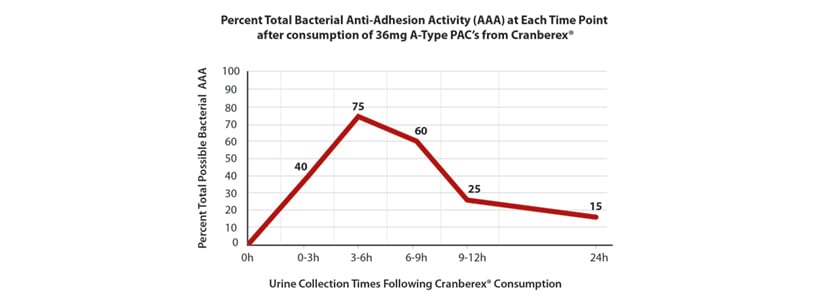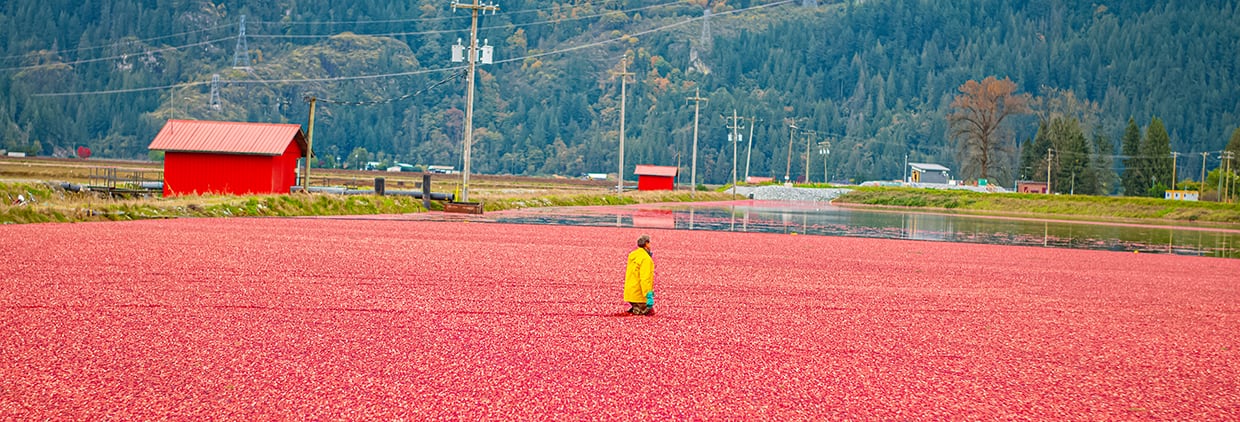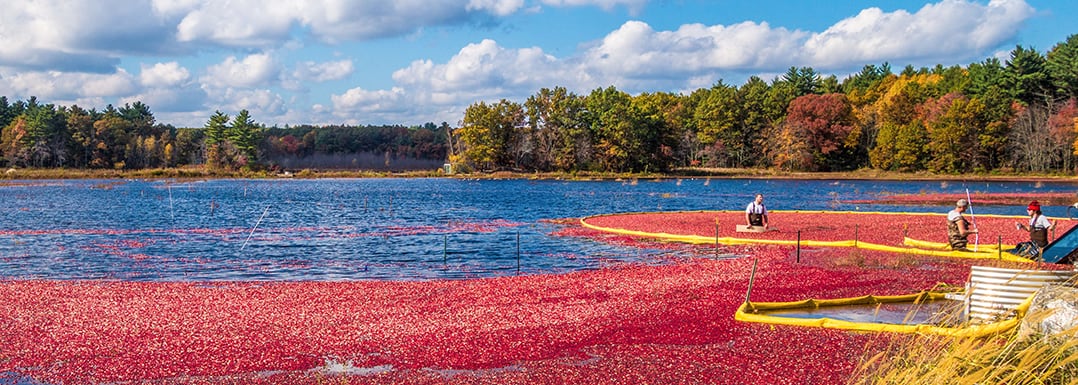The Oregon cranberry harvest heads into a strong year.
The annual US cranberry supply now totals around 400,000 tons.¹ Most is produced in the Northeast states, primarily Wisconsin and Massachusetts. However about 4% of this supply comes from small farms on the Oregon coast where the cool and misty Pacific breezes help to produce cranberries that have special qualities for creating extracts with high levels of A-type PACs.
The Oregon harvest starts in September, and Robert Mckenzie a key grower and harvest consolidator in the area reports that: ‘The Oregon cranberry crop looks to be good this year, but not a bumper crop. The colder than normal spring held the vines back but warmer than normal summer has caught everything back up. The lack of rainfall has been a challenge’.
That’s all pretty good news – the Oregon coast can be more unpredictable than other areas and its high PAC berries are key to producing some of the premium extracts in the effective urinary tract health (UTH) supply chain.
Though the annual cranberry harvest may not be an event of note to most people, Ethical Naturals closely follows the progress of this event as it takes place on the remote Oregon coast.
Understanding how cranberry extracts benefit UTH
The understanding of how and why cranberry extracts effectively support UTH took almost 100 years of in-depth scientific work since the subject began to be researched in the early 1900s.
It wasn’t until 1984 that the first study was published, establishing that cranberry’s benefits were unique in that they didn’t kill the bacteria causing urinary tract infections, but interfered with the ability of bacteria to adhere to the urinary tract lining.²
This is particularly significant as today UTIs are the most common outpatient infections in the US. It’s estimated that they cause about 10.5 million doctor’s office visits each year.³ As most of these cases are caused by bacteria, they are generally treated with lengthy or repeated cycles of antibiotics.
This has resulted in increases in antibiotic resistance that has alarmed health researchers both in the US and the EU.⁴ Because the anti-adhesion activity (AAA) of high-grade cranberry extracts doesn’t kill bacteria, but causes them to pass through the urinary tract, there is less chance of selection of resistant bacterial strains.⁵
Research shows why some cranberry extracts are more effective than others
How and why are some cranberry extracts effective in supporting UTH, while others have limited benefits? A breakthrough in answering this question was made in 1998 when leading cranberry researcher Amy Howell published a paper that identified the proanthocyanidins (PACs) in cranberry as being the compounds responsible for their unique activity.⁶
However, this still left a mystery to be solved. PACs are ubiquitous in nature, responsible for the red and purple colors in all fruits. So why do the PACs in Cranberry have this unique AAA, while PACs from other fruits don’t have this benefit? Also why are some cranberry products more effective than others.
These important questions were resolved in 2000 with the publication of two studies by Amy Howell and L.Y Foo. These showed that cranberry contains unique A-Type PACs that are not present in other fruits.
Another study published in 2005, ‘A-Type cranberry proanthocyanidins and uropathogenic bacteria in anti-adhesion activity’ confirmed these results. The dosage found in these studies to be effective in supporting UTH is 36mg - 72mg/day of A-Type PACs.⁶⁻⁷
However, the A-Type PACs in cranberry are difficult to concentrate or extract, even with considerable expertise. This is part of the reason why studies show that the levels of A-Type PACs vary widely in marketed products. For example, a recent study published in Food Control found that 7 out of 10 products tested were found to contain low or poor quality PAC levels.⁸
Cranberex and Oregon cranberry
Oregon has always been the primary source for the cranberry fruit used to manufacture Cranberex. One reason for this is that Oregon cranberry generally has higher levels of the A-Type PAC’s than other areas. A report published in American Herbal Pharmacopoeia found the following numbers: Oregon (70mg/100g), Massachusetts (42mg/100g) and Wisconsin (37mg/100g). Content in the juice and pulp of the fruit is even lower.⁹
Cranberex, standardized to contain 15% A-Type PAC’s, delivers 36mg of this key constituent per capsule or 72mg per 2 capsules, tested by the approved DMAC method. Though cranberries contain a wide range of PACs, the A-type PACs only amount to a very small percentage generally about 70mg per 100g in Oregon sourced cranberry.
Thus, very high concentrations and sophisticated extraction methods are required to achieve the effective dosage levels. This is one reason why many cranberry extracts do not contain these levels of A-type PACs but are often standardized for total PAC levels by different test methods that appear to give much higher results.
A key Cranberex study by Amy Howell at Rutgers University
Another multicentric, randomized, double blind clinical trial was conducted by Amy Howell at Rutgers University in 2017 using Cranberex brand cranberry extract from Ethical Naturals Inc. (ENI). The results clearly affirmed a bacterial anti-adhesion effect in urine based upon a 36mg dosage of cranberry A-type PAC (tested by DMAC method). It also found that effectiveness was dose-dependent, prolonged up to 24 hours with 72mg of A-Type PACs.¹⁰

Brands focused on offering cranberry supplements that deliver the benefits consumers expect will be pleased to hear that the 2025 harvest of Oregon Coast cranberries is moving towards a strong supply for 2026. As more people seeking UTH support understand the difference that science-backed premium extracts can make, the demand for these special products continues to grow.
References
- Statista. Production volume of cranberries in the United States from 2000 to 2024.
- Sobota, AE. Inhibition of bacterial adherence by cranberry juice: potential use for the treatment of urinary tract infections. J Urol. 1984 May;131(5):1013-6.
- Medina, M.; et al. An introduction to the epidemiology and burden of urinary tract infections. Ther Adv Urol. 2019 May 2;11:1756287219832172.
- Mareș, C.; et al. Update on Urinary Tract Infection Antibiotic Resistance-A Retrospective Study in Females in Conjunction with Clinical Data. Life (Basel). 2024 Jan 9;14(1):106.
- Jangid, H.; et al. Cranberry-derived bioactives for the prevention and treatment of urinary tract infections: antimicrobial mechanisms and global research trends in nutraceutical applications. Front. Nutr. 2025 Feb 26; 12.
- Howell, AB.; et al. Inhibition of the adherence of P-fimbriated Escherichia coli to uroepithelial-cell surfaces by proanthocyanidin extracts from cranberries. N Engl J Med. 1998 Oct 8;339(15):1085-6.
- Howell, AB.; et al. A-type cranberry proanthocyanidins and uropathogenic bacterial anti-adhesion activity. Phytochemistry. 2005 Sep;66(18):2281-91.
- Boudesocque-Delaye, L.; et al. Quality control of commercial cranberry products: HPTLC-densitometry a new deal. Food Control. 2018; 86: 214-2236.
- American Herbal Pharmacopoeia and Therapeutic Compendium (2016). Cranberry Fruit, Vaccinium macrocarpon Aiton, Revision. Page 15.
- Howell, A.B.; Bacterial Anti-Adhesion Activity of Human Urine: Cranberex® (Ethical Naturals). Rutgers University. Feb 2017.






